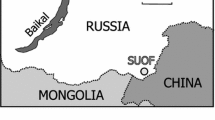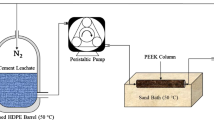Abstract
According to the present concept for final storage of spent nuclear fuel in Sweden, the spent fuel, encapsulated in copper or copper/steel canisters, will be placed in tunnels in a deep rock formation. The canisters will be surrounded by compacted bentonite clay acting as a buffer material. In connection with a safety analysis of such a storage facility, the total solubility of certain elements (e.g., uranium) as well as the transport properties (e.g., retardation due to sorption on mineral surfaces) of the long-lived radionuclides released from the canister have to be predicted or measured. The chemical conditions, governing the solubility and speciation of trace elements encountered in and around the repository depend on interactions between the ground water and the engineering materials in the repository and a production of oxidants due to radiolysis in the spent fuel. In the present study the speciation and solubility of uranium and neptunium in a bentonite-ground water system and in ground waters with compositions measured at a site at äspö, SE Sweden, have been calculated. The calculations have been carried out using a recent version of the geochemical computer code PHREEQE and the database HATCHES 5.0. Predictions of the uranium and neptunium concentrations in the ground water in the vicinity of a damaged high level waste repository have also been performed. The uranium concentration in the water in the bentonite barrier is predicted to be of the same order of magnitude or lower than that found in some granitic ground waters. For neptunium the calculations are uncertain due to the small amount of experimentally determined thermodynamic data and few verifications under the conditions (pH - Eh - carbonate concentration) considered. The predicted concentrations (ca 10−12 m, corresponds to ca 0.006 Bq/l) may be regarded as high, considering the high toxicity of neptunium and its long half-life.
Similar content being viewed by others
References
Ahlbom, K., Andersson, P., Ekman, L., Gustafson, E., Smellie, J. and Tullborg, E.-L. (1986) Preliminary investigation of fracture zones in the Brändan area, Finnsjön study site. Swedish Nuclear Fuel and Waste Management Co. Report SKB TR 86-05, Stockholm.
Ahrland, S. (1986) Solution chemistry and kinetics of ionic reactions. In The Chemistry of the Actinide Elements (eds. J. J. Katz, G. G. Seaborg, and L. R. Morss), 2nd ed, Chapman and Hall, London.
Allard, B. (1983) Actinide solution equilibria and solubilities in geologic systems. Swedish Nuclear Fuel and Waste Management Co. Report SKB TR-83-35, Stockholm.
Allard, B., Olofsson, U. and Torstenfelt, B. (1984) Environmental actinide chemistry. Inorg. Chim. Acta 94, 205–221.
Andersson, K. (1988) Complexation of actinides with phosphate and organic complex formers in deep groundwaters. Swedish Nuclear Power Inspectorate Report SKi TR 88:10, Stockholm.
Bond, K. A., Moreton, A. D. and Heath, T. G. (1992) HATCHES database, NEA release 5.0. NEA Paris.
Colin-Blumenfeld, M. (1987) Hydrogéochimie de l'uranium et du thorium. Speciation de l'uranium dans les eaux naturelles (Vosges, Alsace). Hydrogéochimie du gisement d'uranium de Coutras (Gironde). Solubilité experimentale de ThO2 à 25 ‡C, 105 Pa. Thesis, Université de Nancy I, Nancy.
Dekkers, M. J., Vriend, S. P., van der Veijden, C. H. and van Gaans, P. F. M. (1989) Uranium anomaly evaluation in groundwaters: A hydrogeochemical study in the Nisa region, Portugal. Appl. Geochem. 4, 375–394.
Emrén, A. (1995) Personal communication, Department of Nuclear Chemistry, Chalmers University of Technology, S-412 96 Göteborg.
Eriksen, T. E., Ndalamba, P., Cui, D., Bruno, J., Caceci, M. and Spahiu, K. (1993) Solubility of the Redox-sensitive radionuclides 99Tc and 237Np under reducing conditions in neutral to Alkaline solutions. Effect of Carbonate}. Swedish Nuclear Fuel and Waste Management Co. Report SKB TR 93-18, Stockholm.
Ewart, F. T., Gore, S. J. M. and Williams, S. J. (1985) The solubility of Neptunium (IV) at high pH}. AERE Harwell report AERA R 11975.
Finch, R. and Ewing, R. (1991) Uraninite alteration in an oxidizing environment and its relevance to the disposal of spent nuclear fuel. Swedish Nuclear Fuel and Waste Management Co. Report SKB TR 91-15, Stockholm.
Forsyth, R. S. (1983) 1. The application of PIE techniques to the study of the corrosion of spent oxide fuel in deep-rock groundwaters. 2. Spent fuel degradation. Swedish Nuclear Fuel and Waste Management Co. Report SKB TR 91-03, Stockholm.
Gascoyne, M. (1989) High levels of Uranium in groundwaters at Canada's underground research laboratory, Lac du Bonnet, Manitoba, Canada. Appl. Geochem. 4, 577–591.
Hakanen, M. and Lindberg, A. (1991) Sorption of Neptunium under oxidising and reducing conditions. Radiochim. Acta 52/53, 147–151.
Johnston, R. M. and Miller, H. G. (1983) The effect of pH on the stability of smectite. Atomic Energy of Canada Report AECL-8366.
KBS-3 (1983) Final storage of spent nuclear fuel — KBS-3. Swedish Nuclear Fuel and Waste Management Co., Stockholm
Kornfält, K.-A. and Wikman, H. (1987) Description to the map of solid rocks around Simpevarp. äspö Hard Rock Laboratory Progress reports PR 25–87–02 & PR 25–87–02a, Swedish Nuclear Fuel and Waste Management Co, Stockholm.
Kornfält, K.-A. and Wikman, H. (1988) The rocks of äspö island. Description to the detailed maps of solid rocks including maps of 3 uncovered trenches. äspö Hard Rock Laboratory Progress Report PR 25–88–12, Swedish Nuclear Fuel and Waste Management Co, Stockholm.
Langmuir, D. (1978) Uranium solution-mineral equilibria at low temperatures with applications to sedimentary ore deposits. Geochim. Cosmochim. Acta 42, 547–569.
Lierse, Ch., Treiber, W. and Kim, J.I. (1985) Hydrolysis reactions for Neptunium (IV). Radiochim. Acta 38, 27–28.
Lieser, K.H., Mühlenweg, U. and Sipos-Galiba, I. (1985) Dissolution of Neptunium dioxide in aqueous solutions under various conditions. Radiochim. Acta 39, 35–41.
Lieser, K.H. and Mühlenweg, U. (1988) Neptunium in the hydrosphere and in the geosphere, 1. Chemistry of Neptunium in the Hydrosphere and Sorption of Neptunium from Groundwaters on Sediments under Aerobic and Anaerobic Conditions. Radiochim. Acta 43, 27–35.
Lundén, I. (1992) Geochemical modelling of groundwater chemistry in the cicinity of a repository for spent nuclear fuel. Ph.D. Thesis, Dept. of Nuclear Chemistry, Chalmers University of Technology, Göteborg.
Müller-Vonmoos, M. and Kahr, G. (1983) Mineralogische Untersuchungen von Wyoming Bentonit MX-80 und Montigel. NAGRA Technischer Bericht 83-12, Baden.
Nitsche, H. (1991) Basic research for assessment of geologic nuclear waste repositories: What solubility and speciation studies of transuranium elements can tell us. Mat. Res. Soc. Symp. Proc. Proc. 212, 517–529.
Newton, T. (1985) Actinide carbonate complexes in aqueous solution, in Handbook of the Physics and Chemistry of the Actinides (eds. A. J. Freeman and C. Keller) Elsevier, New York.
Olofsson, U., Allard, B., Torstenfelt, B. and Andersson, K. (1982) Properties and mobilities of actinide colloids in geologic systems, in Sci. Basis for Nucl. Waste Management, Elsevier, New York, p. 755.
Parkhurst, D. L., Thorstenson, D. C. and Plummer, L. N. (1980) PHREEQE- A computer program for geochemical calculations. U.S. Geological Survey Report USGS/WRI-80-96.
Parkhurst, D. L., Thorstenson, D. C. and Plummer, L. N. (1990) PROGRAM PHREEQE version current, July 1, 1990, Entered into RCS 10/16/91 by DL Parkhurst.
Parkhurst, D. L., Thorstenson, D. C. and Plummer, L. N. (1990) PROGRAM PHREEQE version current, July 1, 1990, Entered into RCS 10/16/91 by DL Parkhurst.
Pass (1993) Project on alternative systems study (PASS) final report. Swedish Nuclear Fuel and Waste Management Co. Report SKB TR 93-04, Stockholm
Pusch, R. and Karland, O. (1990) Preliminary report on longevity of montmorillonite clay under repository related conditions. Swedish Nuclear Fuel and Waste Management Co. Report SKB TR-90-44, Stockholm.
Rai, D. and Ryan, J. L. (1985) Neptunium (IV) hydrous oxide solubility under reducing and carbonate conditions. Inorg. Chem. 24, 247–251.
SKi (1991) Swedish Nuclear Power Inspectorate Report SKi 91-23, Stockholm.
Snellman, M. (1987) Factors effecting carbonate equilibria in natural waters. Technical Research Centre of Finland Report YJT-87-19.
Snellman, M., Uotila, H. and Rantanen, J. (1987) Laboratory and modelling studies of sodium bentonite groundwater interaction. Mat. Res. Soc. Symp. Proc. 84, 781–790.
Wanner, H. and Forest, I. (eds) (1992) Chemical Thermodynamics of Uranium. North-Holland, Amsterdam.
Wikberg, P. (Ed), Gustafson, E., Rhén, I. and Stanfors, R. (1991) äspö hard rock laboratory, evaluation and conceptual modelling based on the pre-investigations 1986–1990. Swedish Nuclear Fuel and Waste Management Co. Report SKB TR 91-22, Stockholm.
Author information
Authors and Affiliations
Rights and permissions
About this article
Cite this article
Lundén, I., Andersson, K. & Skarnemark, G. Modelling of uranium and neptunium chemistry in a deep rock environment. Aquat Geochem 2, 345–358 (1996). https://doi.org/10.1007/BF00115976
Received:
Revised:
Issue Date:
DOI: https://doi.org/10.1007/BF00115976




